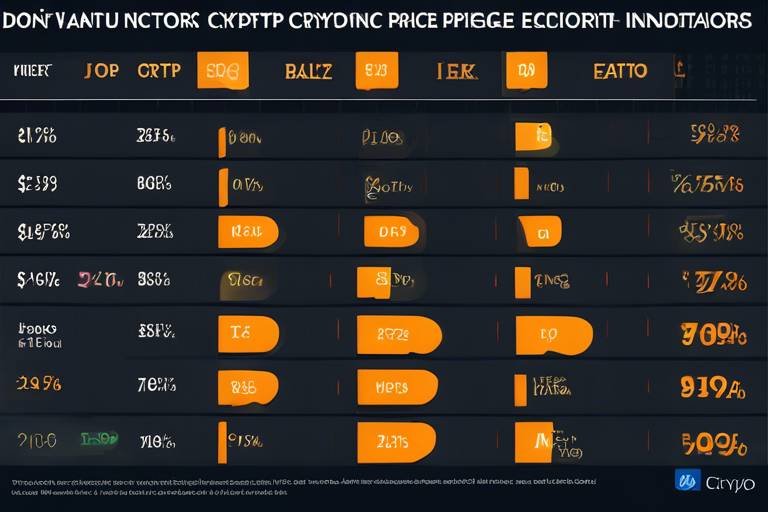How Institutional Investment is Shaping the Crypto Market
The world of cryptocurrency is a vibrant and ever-evolving landscape, and at the heart of its transformation lies the influence of institutional investment. Over the past few years, we've witnessed a remarkable shift as institutional players, such as hedge funds, pension funds, and large corporations, have begun to dip their toes into the crypto waters. This influx of capital is not just a passing trend; it signifies a profound change in how cryptocurrencies are perceived and integrated into the broader financial ecosystem. But what does this mean for the average investor? And how is this reshaping the market dynamics? Let's dive deeper into the transformative impact of institutional investment on the cryptocurrency market.
Institutional investors are increasingly entering the crypto space, driven by the potential for high returns and diversification. The traditional financial world has long viewed cryptocurrencies with skepticism, often labeling them as speculative assets. However, as the market matures and more robust data emerges, these institutions are starting to recognize the unique opportunities that digital assets present. Factors contributing to their growing interest include:
- Potential for High Returns: With the meteoric rise in prices of cryptocurrencies like Bitcoin and Ethereum, institutions are looking at the potential for significant gains.
- Diversification: Cryptocurrencies offer a new asset class that can enhance portfolio diversification, potentially reducing overall risk.
- Institutional Infrastructure: The development of custodial services and regulated exchanges has made it easier and safer for institutions to invest in cryptocurrencies.
This shift is not merely about chasing returns; it’s about recognizing that cryptocurrencies can play a crucial role in a well-rounded investment strategy. The entry of institutional investors is akin to a stamp of approval, lending credibility to the entire market.
One of the most intriguing aspects of institutional investment is its dual nature regarding market volatility. On one hand, large-scale investments can bring stability to the often-turbulent crypto market. When institutions invest, they typically do so with a long-term perspective, which can help dampen the wild price swings that retail investors often experience. On the other hand, the sheer volume of capital that institutions can deploy means that their actions can also exacerbate volatility. For instance, a significant sell-off by an institutional investor can lead to sharp declines in prices, creating a ripple effect throughout the market.
To navigate this volatile landscape, institutional investors employ a variety of risk management strategies. They understand that the crypto market is not for the faint of heart and use several techniques to protect their investments. Some of these strategies include:
Hedging is crucial for institutional investors to protect their portfolios. By using derivatives such as options and futures, they can mitigate potential losses. For example, if an institution holds a large amount of Bitcoin, they might purchase a futures contract to sell Bitcoin at a predetermined price, effectively locking in their profits and minimizing the risk of a price drop.
Diversification is another key strategy. By spreading investments across various cryptocurrencies and traditional assets, institutional investors can reduce their exposure to any single asset's volatility. This balanced approach allows them to participate in the growth of the crypto market while managing risk effectively.
Regulatory frameworks significantly affect institutional investment in cryptocurrencies. The evolving landscape of regulations can either encourage or deter institutional participation. Institutions are keenly aware of compliance requirements and are often at the forefront of advocating for clearer regulations. As regulations become more defined, we can expect further institutional involvement, which will likely lead to greater market stability and investor confidence.
The influx of institutional capital is driving the maturation of the cryptocurrency market. This participation is fostering innovation, improving infrastructure, and enhancing market credibility. The presence of institutional investors acts as a catalyst for change, prompting the development of better trading platforms, custodial services, and security measures.
Institutional investments are pushing for better infrastructure in the crypto space. Advanced trading platforms that can handle large volumes of transactions and custodial services that ensure the security of digital assets are becoming increasingly common. This development not only benefits institutional players but also enhances the overall user experience for retail investors.
The rise of institutional interest has led to the creation of innovative financial products tailored for institutional investors. These include:
- Exchange-Traded Funds (ETFs): Allowing investors to gain exposure to cryptocurrencies without directly owning them.
- Crypto Funds: Managed funds that invest in a diversified portfolio of cryptocurrencies.
Such products make it easier for institutions to invest in the crypto market while adhering to their investment mandates.
As the crypto market evolves, so do the strategies of institutional investors. We can expect to see a greater emphasis on sustainability and environmental considerations, particularly as the conversation around the energy consumption of cryptocurrencies continues to grow. Additionally, the integration of blockchain technology into traditional financial systems may open new avenues for institutional participation. The future is bright, and the landscape will continue to shift as institutions adapt to the changing market dynamics.
Q: What is the significance of institutional investment in the crypto market?
A: Institutional investment brings credibility, stability, and significant capital to the crypto market, fostering its maturation and acceptance as a legitimate asset class.
Q: How do institutional investors manage risk in the crypto market?
A: They employ various strategies such as hedging and diversification to mitigate risks associated with the inherent volatility of cryptocurrencies.
Q: What impact do regulations have on institutional investment?
A: Regulatory frameworks can either encourage or deter institutional participation, and clearer regulations are expected to lead to increased involvement and market stability.

The Rise of Institutional Investors
In recent years, the cryptocurrency market has witnessed a remarkable transformation, largely fueled by the **influx of institutional investors**. These are not just your average retail investors; we’re talking about hedge funds, pension funds, and even large corporations stepping into the crypto arena. But what’s driving this wave of institutional interest? Well, it's a mix of factors that make the crypto space incredibly appealing.
First off, the potential for **high returns** is a significant draw. With traditional markets offering limited growth opportunities, many institutional investors are eager to tap into the explosive growth that cryptocurrencies can provide. Just think about it: Bitcoin and Ethereum have seen astronomical price increases over the past decade. This potential for outsized returns can be likened to discovering a hidden treasure chest in a vast ocean—who wouldn’t want to dive in?
Moreover, **diversification** is another key reason why institutions are entering the market. By adding cryptocurrencies to their portfolios, these investors can spread their risk across different asset classes. This is particularly important in today’s uncertain economic climate, where traditional assets can be volatile. According to recent studies, a diversified portfolio that includes a small percentage of crypto can enhance overall returns while mitigating risks. It’s like adding a pinch of spice to a dish; it can elevate the entire flavor profile!
Additionally, the **evolving landscape of technology** and infrastructure in the crypto space has made it more accessible and secure for institutional investors. With advancements in custodial services, trading platforms, and regulatory frameworks, the barriers that once deterred these investors are gradually being dismantled. They now have the tools and resources to navigate this new frontier with confidence. This shift can be compared to upgrading from a basic map to a GPS system—it makes the journey much more manageable and efficient.
To illustrate the growth of institutional investment in cryptocurrencies, let’s take a look at some statistics:
| Year | Institutional Investment in Crypto (in Billion USD) |
|---|---|
| 2018 | 1.5 |
| 2019 | 3.0 |
| 2020 | 7.5 |
| 2021 | 15.0 |
| 2022 | 30.0 |
This table clearly shows a **staggering increase** in institutional investment over just a few years. It’s evident that institutions are not just dipping their toes in; they’re diving headfirst into the crypto pool!
In conclusion, the rise of institutional investors in the cryptocurrency market is reshaping the landscape in profound ways. Their pursuit of high returns, diversification strategies, and the advancements in crypto infrastructure are all contributing to this trend. As more institutions embrace digital assets, we can expect to see further maturation of the market, making it an exciting time for all participants involved.

Market Volatility and Institutional Influence
The cryptocurrency market is notorious for its wild fluctuations, and institutional investors play a pivotal role in shaping this volatility. When large sums of money enter or exit the market, it can create ripples that affect prices dramatically. For instance, a single investment from a hedge fund can send Bitcoin soaring or crashing within hours. This phenomenon raises a critical question: Are institutional investors stabilizing the market, or are they merely adding fuel to the fire?
On one hand, institutional investment can provide a layer of stability that individual investors often lack. With their extensive resources and sophisticated analysis, institutional players can implement strategies that help cushion the market against severe downturns. For example, during periods of market instability, these investors may choose to hold onto their assets rather than sell them off in panic, which can reduce the overall selling pressure. This behavior can create a sense of confidence among retail investors, encouraging them to stay in the market rather than flee at the first sign of trouble.
However, the flip side is equally compelling. Institutional investors can also exacerbate volatility. When they decide to liquidate their positions, the impact can be catastrophic. A sudden sell-off can trigger a chain reaction, leading to a rapid decline in prices as other investors rush to exit their positions. This scenario was evident during the market crash in March 2020, when a wave of institutional selling contributed to a steep decline in cryptocurrency values. The psychological impact of such movements cannot be understated; they create a climate of fear and uncertainty that can lead to further volatility.
To better understand the dynamics at play, let’s look at a simplified table that illustrates the relationship between institutional investment and market volatility:
| Scenario | Institutional Action | Market Reaction |
|---|---|---|
| Investment Surge | Large buy orders from institutional investors | Price increase, reduced volatility |
| Mass Liquidation | Institutional sell-off | Price drop, increased volatility |
In addition to these direct influences, institutional investors also shape investor sentiment. Their participation lends a degree of legitimacy to the cryptocurrency market, attracting more retail investors who may have been hesitant to enter previously. This influx of new money can lead to increased trading volumes, which can further amplify price movements. Essentially, institutional involvement acts as a double-edged sword; it can both stabilize and destabilize the market, depending on the circumstances.
As we look to the future, understanding the intricate relationship between institutional investors and market volatility will be crucial. Will they continue to act as stabilizers, or will their influence lead to greater unpredictability? The answer may hinge on how these investors adapt to the unique challenges presented by the crypto landscape.
- What is the role of institutional investors in the cryptocurrency market?
Institutional investors bring significant capital and expertise, influencing market dynamics, stability, and investor sentiment. - How do institutional investments affect market volatility?
Large-scale investments can both stabilize and exacerbate volatility, depending on whether they are buying or selling. - What strategies do institutional investors use to manage risks?
They employ various risk management techniques, including hedging and diversification, to mitigate potential losses.

Risk Management Strategies
When it comes to navigating the unpredictable waters of the cryptocurrency market, institutional investors have to be as savvy as a seasoned sailor. They understand that with great potential for profit comes an equally great potential for loss. This is where come into play, acting as a life raft in turbulent seas. These strategies are not just a safety net; they are essential tools that help institutional investors make informed decisions and protect their investments from the inherent volatility of digital assets.
One of the primary techniques employed by institutional investors is hedging. This approach allows them to offset potential losses in their crypto investments by taking opposite positions in related assets. For instance, if an investor holds a significant amount of Bitcoin, they might choose to short Bitcoin futures contracts. This way, if the price of Bitcoin drops, the gains from the short position can help mitigate the losses on the actual Bitcoin holdings. Hedging can be likened to taking out insurance on your car; it may seem like an extra expense, but it can save you from substantial financial damage in case of an accident.
Another critical strategy is diversification. Just as a well-balanced diet is crucial for physical health, a diversified portfolio is vital for financial health. Institutional investors are increasingly spreading their investments across various cryptocurrencies and traditional assets. This approach not only reduces risk but also opens up opportunities for greater returns. By investing in a mix of established coins like Bitcoin and Ethereum, alongside newer altcoins, institutions can cushion themselves against the volatility of individual assets. For example, if Bitcoin experiences a downturn, other assets in the portfolio may remain stable or even appreciate, helping to balance the overall performance.
To put it simply, institutional investors are like skilled chefs in a kitchen, carefully selecting ingredients to create a balanced dish. They know that relying solely on one ingredient can lead to disaster. Therefore, they mix different assets to create a portfolio that can withstand the heat of market fluctuations. This strategy not only helps in managing risk but also enhances the potential for long-term gains.
Moreover, technology plays a significant role in risk management. Many institutional investors leverage advanced analytics and algorithms to monitor market trends and assess risks in real-time. This technological edge allows them to react swiftly to market changes, making data-driven decisions that can significantly reduce exposure to risk. Think of it as having a high-tech navigation system on your boat, guiding you through the fog and helping you avoid hidden dangers.
In conclusion, risk management strategies are not merely optional for institutional investors; they are fundamental to thriving in the ever-evolving cryptocurrency landscape. By employing a combination of hedging, diversification, and cutting-edge technology, these investors can navigate the choppy waters of the crypto market with confidence, ultimately leading to more stable and profitable outcomes.
- What is the primary goal of risk management in cryptocurrency investments?
Risk management aims to protect investments from significant losses while maximizing potential returns, especially given the high volatility of the crypto market. - How do institutional investors hedge their crypto investments?
Institutional investors often use financial instruments such as futures and options to hedge against price fluctuations in cryptocurrencies. - Why is diversification important for institutional investors?
Diversification helps mitigate risk by spreading investments across different assets, reducing the impact of any single asset's poor performance on the overall portfolio. - What role does technology play in risk management?
Technology enables institutional investors to analyze market data and trends in real-time, allowing for quicker, more informed decision-making to manage risks effectively.

Hedging Techniques
When it comes to navigating the tumultuous waters of the cryptocurrency market, serve as invaluable tools for institutional investors. Just like a seasoned sailor uses a compass to steer clear of storms, these investors employ various strategies to protect their portfolios from the unpredictable waves of price fluctuations. One of the primary methods they utilize is options trading, which allows them to secure the right, but not the obligation, to buy or sell a cryptocurrency at a predetermined price. This technique provides a safety net against sudden market downturns, allowing investors to limit their potential losses.
Another popular hedging strategy is the use of futures contracts. By agreeing to buy or sell a specific amount of cryptocurrency at a set price on a future date, institutional investors can lock in prices and reduce the risk of adverse price movements. This is particularly important in a market as volatile as crypto, where prices can swing dramatically within hours. For instance, if an investor anticipates a decline in Bitcoin's price, they can sell futures contracts to offset potential losses in their spot holdings.
Moreover, diversification plays a crucial role in hedging strategies. Institutional investors often spread their investments across various cryptocurrencies and even include traditional assets like stocks and bonds in their portfolios. This approach not only mitigates risks associated with any single asset but also enhances overall portfolio stability. By holding a mix of assets, investors can cushion the impact of a downturn in one sector with gains in another.
To illustrate the effectiveness of these hedging techniques, consider the following table that summarizes some common strategies employed by institutional investors:
| Hedging Technique | Description | Benefits |
|---|---|---|
| Options Trading | Secures the right to buy/sell at a specific price | Limits potential losses during downturns |
| Futures Contracts | Agrees to buy/sell at a set price in the future | Locks in prices, reducing risk of price swings |
| Diversification | Spreading investments across various assets | Reduces overall portfolio risk |
Additionally, institutional investors may also explore inverse exchange-traded products (ETPs). These financial instruments are designed to profit from a decline in the price of an underlying asset, effectively allowing investors to hedge against downturns without liquidating their holdings. This strategy can be particularly useful during bearish market trends, providing a buffer against potential losses.
In conclusion, employing effective hedging techniques is essential for institutional investors aiming to navigate the volatile landscape of cryptocurrencies. By utilizing options trading, futures contracts, diversification, and inverse ETPs, they can safeguard their investments and maintain a steady course amid the market's unpredictable nature. As the crypto market continues to evolve, these strategies will undoubtedly play a pivotal role in shaping the investment approaches of institutional players.
- What is hedging in the context of cryptocurrency? Hedging in cryptocurrency refers to strategies used by investors to protect their portfolios from potential losses due to price fluctuations.
- Why do institutional investors use hedging techniques? Institutional investors use hedging techniques to mitigate risks associated with market volatility, ensuring their investments remain stable during downturns.
- What are some common hedging techniques? Common hedging techniques include options trading, futures contracts, diversification, and the use of inverse exchange-traded products.
- How does diversification help in hedging? Diversification helps in hedging by spreading investments across various assets, which reduces the impact of a downturn in any single asset on the overall portfolio.

Diversification Approaches
Diversification is a fundamental concept in investing, and it's especially crucial in the volatile world of cryptocurrencies. For institutional investors, the goal is to spread risk across various assets to minimize potential losses. Think of it like a well-balanced diet; just as you wouldn’t want to eat only one type of food, investing in a single asset class can leave you vulnerable to significant downturns. By diversifying their portfolios, institutional investors can achieve a more stable return on investment while still capitalizing on the unique opportunities that the crypto market presents.
One of the primary strategies institutions use is to combine traditional assets with digital currencies. This approach not only reduces exposure to the inherent risks of cryptocurrencies but also allows for greater overall portfolio stability. For example, an institutional investor might allocate funds into a mix of stocks, bonds, and cryptocurrencies, thereby harnessing the growth potential of digital assets while maintaining a safety net with more stable investments.
Additionally, the diversification of cryptocurrencies themselves plays a vital role. Just as a farmer wouldn’t plant only one crop, institutional investors are increasingly looking to hold a variety of digital assets. This could include major players like Bitcoin and Ethereum, alongside smaller altcoins that may have higher growth potential. By diversifying within the crypto space, investors can mitigate risks associated with market fluctuations and capitalize on different trends that may emerge across various digital currencies.
To illustrate the concept of diversification in institutional portfolios, consider the following table that outlines a hypothetical asset allocation:
| Asset Class | Allocation Percentage |
|---|---|
| Bitcoin | 30% |
| Ethereum | 25% |
| Stablecoins | 15% |
| Traditional Stocks | 20% |
| Bonds | 10% |
This table showcases a balanced investment approach, where a significant portion is allocated to cryptocurrencies while still retaining traditional assets to cushion against volatility. By employing such diversification strategies, institutional investors can adapt to the fast-paced changes in the crypto market, ensuring they remain resilient in the face of potential downturns.
Ultimately, diversification is not just a safety net; it’s a proactive strategy that allows institutional investors to explore the vast landscape of opportunities within the cryptocurrency market. As they continue to refine their approaches, we can expect to see more innovative methods of diversification that will shape the future of institutional investment in crypto.
- What is diversification in investment?
Diversification is the practice of spreading investments across various assets to reduce risk. It helps protect against significant losses in any single investment. - Why is diversification important for institutional investors?
It allows them to balance risk and reward, ensuring that their portfolios remain stable even during market volatility. - How do institutional investors diversify in the crypto market?
They often mix traditional assets with cryptocurrencies and hold a variety of digital currencies to mitigate risks. - What are some common strategies for diversification?
Common strategies include asset allocation across different classes and investing in a range of cryptocurrencies.

Regulatory Considerations
The landscape of cryptocurrency is ever-evolving, and with this evolution comes a series of that institutional investors must navigate. Regulatory frameworks are not merely bureaucratic hurdles; they are essential for the legitimacy and growth of the crypto market. As institutional players make their entry, they bring with them a heightened demand for clarity and compliance. This is crucial because, without a solid regulatory foundation, the market can remain a wild west of uncertainty, which can deter potential investors.
One of the most significant factors influencing institutional investment in cryptocurrencies is the regulatory environment. Different countries have adopted varying stances toward crypto assets, ranging from outright bans to full acceptance. For instance, nations like the United States and Germany have made strides in creating clear guidelines, while others remain ambiguous, leading to confusion and hesitation among institutional investors. This inconsistency can create a patchwork of regulations that complicates cross-border investments and operations.
Moreover, regulatory bodies are increasingly focusing on issues such as anti-money laundering (AML) and know your customer (KYC) requirements. These regulations aim to prevent illicit activities and ensure that transactions are transparent. For institutional investors, adhering to these regulations is not just about compliance; it’s about building trust with clients and stakeholders. As a result, many institutions are investing in robust compliance frameworks to meet these regulatory demands.
Additionally, the emergence of stablecoins has prompted regulators to consider how these digital assets fit into existing financial systems. Stablecoins, which are pegged to traditional currencies, present unique challenges and opportunities for regulatory bodies. Institutions investing in stablecoins must stay informed about the evolving regulations surrounding these assets, as any changes can significantly impact their investment strategies.
As we look toward the future, it’s clear that regulatory considerations will continue to play a pivotal role in shaping the cryptocurrency market. Institutions that proactively engage with regulators and advocate for sensible policies will likely find themselves at a competitive advantage. Understanding the regulatory landscape is not just about compliance; it’s about seizing opportunities and mitigating risks in a rapidly changing environment.
In summary, the regulatory framework surrounding cryptocurrencies is complex and varies significantly across jurisdictions. Institutional investors must remain vigilant and adaptable, ensuring that they not only comply with current regulations but also anticipate future changes that could impact their investments. This proactive approach will be essential for navigating the dynamic and often unpredictable world of cryptocurrency.
- What are the key regulatory challenges facing institutional investors in cryptocurrency? Institutional investors face challenges such as inconsistent regulations across jurisdictions, compliance with AML and KYC requirements, and the evolving landscape of stablecoin regulations.
- How can institutional investors ensure compliance with cryptocurrency regulations? By investing in robust compliance frameworks, staying informed about regulatory changes, and engaging with regulatory bodies, institutional investors can better navigate the complex regulatory environment.
- Why is regulatory clarity important for institutional investment in cryptocurrencies? Regulatory clarity fosters trust and confidence among investors, enabling them to participate in the market without fear of sudden regulatory changes that could impact their investments.

Impact on Market Maturity
The influx of institutional capital is not just a trend; it's a game-changer that is actively reshaping the cryptocurrency market's landscape. As institutional investors, such as hedge funds, pension funds, and family offices, pour significant resources into digital assets, they bring with them a level of credibility and stability that has been sorely needed in this often volatile space. This newfound interest is akin to the arrival of seasoned players on a playground, elevating the game and setting new standards for participation.
One of the most profound impacts of institutional investment is the acceleration of market maturity. With large sums of money at stake, institutions demand enhanced infrastructure and regulatory clarity. This has led to a surge in the development of more sophisticated trading platforms, custodial services, and security measures that cater to the unique needs of institutional investors. For instance, exchanges are now implementing advanced features such as algorithmic trading, which allows institutions to execute trades at optimal prices without causing significant market disruption.
Furthermore, institutional involvement is fostering a culture of innovation within the cryptocurrency sector. As these investors seek to diversify their portfolios, they are also pushing for the creation of innovative financial products that can accommodate their investment strategies. The emergence of Exchange-Traded Funds (ETFs) and crypto funds tailored specifically for institutional investors is a testament to this shift. These products not only provide institutions with exposure to cryptocurrencies but also offer a layer of regulatory oversight that enhances investor confidence.
As the market matures, we also witness an increase in transparency and accountability. Institutional investors often require extensive due diligence before committing capital, which has led to a demand for better reporting standards and compliance measures across the board. This heightened scrutiny is beneficial for all market participants, as it reduces the risk of fraud and enhances the overall integrity of the crypto ecosystem.
In summary, the impact of institutional investment on market maturity is multifaceted. It drives innovation, enhances infrastructure, and fosters a more credible and stable environment for all investors. As we look to the future, the ongoing evolution of the cryptocurrency market will likely continue to reflect the influence of institutional players, making it an exciting space to watch.
- What are the main benefits of institutional investment in cryptocurrencies?
Institutional investment brings credibility, stability, and enhanced infrastructure to the crypto market, which benefits all investors.
- How do institutional investors influence market volatility?
They can stabilize the market by providing liquidity, but large-scale investments can also exacerbate price fluctuations during significant trades.
- What innovative products have emerged due to institutional interest?
Products such as ETFs and crypto funds have been developed to cater specifically to the needs of institutional investors.

Infrastructure Development
As institutional investors dive deeper into the cryptocurrency market, one of the most significant impacts they have is on . Think of the crypto market as a bustling city; without proper roads, bridges, and public services, it can become chaotic and hard to navigate. Institutional investment acts like the construction crews and city planners, laying down the essential frameworks that make this digital landscape more navigable and secure.
One of the primary areas where institutional investment is making waves is in the development of trading platforms. These platforms are evolving from basic exchanges into sophisticated ecosystems that can handle large volumes of transactions with speed and efficiency. For instance, institutions require platforms that can facilitate high-frequency trading and provide advanced analytics tools. This demand has led to the emergence of new trading technologies that not only cater to institutional needs but also enhance the overall user experience for retail investors.
Moreover, custodial services are becoming increasingly important. Institutions need to ensure that their digital assets are stored securely, and this has prompted the creation of specialized custodial solutions. These services provide robust security measures, including multi-signature wallets and cold storage options, which significantly reduce the risk of hacks and theft. As more institutions enter the space, the demand for reliable custodial services is driving innovation and competition among providers.
Another critical aspect of infrastructure development is security measures. The crypto world has faced its fair share of high-profile hacks and fraud cases, which have raised concerns about the safety of digital assets. Institutional investors are pushing for better security protocols, leading to the adoption of advanced technologies such as blockchain analytics and smart contracts. These technologies not only enhance security but also help in compliance with regulatory requirements, making the market more attractive to cautious investors.
To summarize the influence of institutional investment on infrastructure development, we can look at the following key areas:
- Enhanced Trading Platforms: Development of sophisticated trading tools and analytics.
- Secure Custodial Solutions: Introduction of advanced security measures for asset storage.
- Improved Security Protocols: Adoption of technologies to protect against theft and fraud.
In conclusion, the infrastructure of the cryptocurrency market is undergoing a transformation fueled by institutional investment. As these investors continue to seek safer and more efficient ways to engage with digital assets, we can expect ongoing improvements that will benefit not only them but the entire crypto ecosystem. This evolution is akin to upgrading a city’s infrastructure to accommodate an influx of new residents, ensuring that everyone can thrive in a more secure and efficient environment.

Innovative Financial Products
As the cryptocurrency market continues to evolve, the influx of institutional investment has catalyzed the development of a variety of designed specifically for this new landscape. These products not only cater to the unique needs of institutional investors but also help bridge the gap between traditional finance and the burgeoning world of digital assets. One of the most notable innovations is the introduction of Exchange-Traded Funds (ETFs), which allow investors to gain exposure to a diversified portfolio of cryptocurrencies without the need to directly purchase and manage the underlying assets.
ETFs have become a hot topic in the investment community, offering a way for institutions to access the crypto market while benefiting from the liquidity and regulatory oversight typical of traditional financial products. For instance, a Bitcoin ETF allows investors to buy shares that represent a specific amount of Bitcoin, thus simplifying the investment process and reducing the complexities associated with direct ownership. This innovation not only attracts institutional investors but also enhances market credibility by providing a regulated framework for investment.
Another exciting development in this space is the emergence of crypto funds, which are tailored to meet the diverse investment strategies of institutions. These funds can be actively managed or follow a more passive approach, depending on the goals of the investors. For instance, some funds focus on long-term holding strategies, while others may engage in high-frequency trading to capitalize on short-term price movements. The variety of options available means that institutions can choose products that align with their risk tolerance and investment objectives.
Additionally, the rise of derivative products such as futures and options has provided institutions with more tools to manage their exposure to cryptocurrency price fluctuations. These derivatives allow investors to hedge against potential losses or speculate on price movements without owning the underlying assets. For example, a futures contract enables an investor to agree on a price for Bitcoin today, with delivery set for a future date, thereby locking in a price and mitigating the risk of volatility.
Here's a brief overview of some of the innovative financial products currently available in the cryptocurrency market:
| Product Type | Description | Benefits |
|---|---|---|
| ETFs | Funds that track the price of cryptocurrencies. | Regulated, liquid, and easy to trade. |
| Crypto Funds | Funds that invest in a diversified portfolio of cryptocurrencies. | Professional management and tailored investment strategies. |
| Derivatives (Futures & Options) | Contracts that allow speculation on price movements without owning the asset. | Risk management and potential for profit in volatile markets. |
Overall, the development of these innovative financial products is not only reshaping the landscape for institutional investors but is also paving the way for greater mainstream adoption of cryptocurrencies. As these products gain traction, we can expect to see an increase in market participation from institutions, which will further legitimize the crypto space and drive continued innovation.
- What are ETFs in the context of cryptocurrency? ETFs are funds that allow investors to buy shares representing a specific amount of cryptocurrency, providing a regulated and liquid way to invest.
- How do crypto funds work? Crypto funds pool capital from multiple investors to create a diversified portfolio of cryptocurrencies, managed by professionals.
- What are the advantages of using derivatives in crypto trading? Derivatives provide institutions with tools to hedge against risks and speculate on price movements without needing to own the underlying assets.

Future Trends in Institutional Investment
The landscape of institutional investment in cryptocurrencies is continually evolving, and as we look to the future, several key trends are shaping the way these investors engage with digital assets. One of the most significant trends is the increasing acceptance of cryptocurrencies by mainstream financial institutions. As traditional banks and investment firms begin to recognize the potential of blockchain technology and digital currencies, we can expect a surge in institutional participation that could further legitimize the market.
Another trend to watch is the development of regulated cryptocurrency products. As regulatory frameworks become clearer and more standardized, institutional investors will likely feel more comfortable allocating funds to crypto assets. This could lead to the creation of a variety of new investment vehicles, such as crypto ETFs and mutual funds, designed specifically for institutional clients. These products would provide a structured way for institutions to gain exposure to the crypto market without the complexities of direct ownership.
Moreover, the integration of advanced technology into the investment process is another trend that cannot be overlooked. Institutions are increasingly leveraging artificial intelligence and machine learning to analyze market trends, assess risks, and make data-driven decisions. This technological shift not only enhances the efficiency of trading strategies but also allows for more sophisticated risk management techniques that can adapt to market volatility.
| Trend | Description |
|---|---|
| Increased Institutional Acceptance | Mainstream financial institutions are beginning to embrace cryptocurrencies, leading to higher participation rates. |
| Regulated Investment Products | The emergence of crypto ETFs and mutual funds will provide structured investment options for institutions. |
| Technological Integration | Use of AI and machine learning for data analysis and risk management will become more prevalent. |
Furthermore, we can anticipate a shift towards sustainable investing within the crypto space. As environmental concerns grow, institutional investors are increasingly prioritizing assets that align with their sustainability goals. This could lead to a rise in investments in cryptocurrencies that utilize eco-friendly mining practices or those that contribute to sustainable projects, transforming the narrative around crypto's environmental impact.
Lastly, the concept of decentralized finance (DeFi) is poised to capture the attention of institutional investors. As these platforms mature and demonstrate their potential for providing liquidity and yield generation, we may see more institutions venturing into DeFi protocols. This could open up a whole new realm of investment opportunities and further blur the lines between traditional finance and blockchain-based finance.
In summary, the future of institutional investment in the cryptocurrency market is bright and full of potential. As acceptance grows, regulatory frameworks solidify, and technology advances, institutional investors will likely play a pivotal role in shaping the next chapter of the crypto landscape.
- What are the main trends in institutional investment for cryptocurrencies? The main trends include increased institutional acceptance, the development of regulated investment products, technological integration, a focus on sustainable investing, and interest in decentralized finance (DeFi).
- How will regulations impact institutional investment in cryptocurrencies? Clearer regulations will likely boost institutional confidence, leading to more significant investments and the creation of structured products like crypto ETFs.
- What role does technology play in institutional investment strategies? Advanced technologies such as AI and machine learning are being used to analyze data, assess risks, and improve trading strategies, making investments more efficient.
Frequently Asked Questions
- What is institutional investment in the crypto market?
Institutional investment refers to the participation of large organizations, such as hedge funds, pension funds, and other financial institutions, in the cryptocurrency market. These investors bring significant capital and expertise, influencing market dynamics and trends.
- Why are institutional investors interested in cryptocurrencies?
Institutional investors are drawn to cryptocurrencies due to the potential for high returns, the opportunity for portfolio diversification, and the growing acceptance of digital assets in the mainstream financial ecosystem. They see crypto as a way to enhance their investment strategies.
- How does institutional investment affect market volatility?
Institutional investment can both stabilize and exacerbate market volatility. Large-scale investments can lead to significant price movements, impacting investor sentiment. When institutions enter or exit the market, it can create ripples that affect the entire crypto landscape.
- What risk management strategies do institutional investors use?
Institutional investors employ various risk management strategies, including hedging techniques and diversification approaches. These strategies help them navigate the inherent volatility of the crypto market and protect their investments from potential losses.
- What are some common hedging techniques in crypto?
Common hedging techniques include using options and futures contracts to offset potential losses in their crypto holdings. These financial instruments allow investors to lock in prices and reduce exposure to market fluctuations.
- How do institutional investors diversify their crypto portfolios?
Institutional investors diversify their crypto portfolios by investing in a variety of digital assets alongside traditional investments. This balanced approach helps mitigate risk and enhances overall portfolio performance.
- What regulatory considerations impact institutional investment?
Regulatory frameworks play a crucial role in shaping institutional investment in cryptocurrencies. Evolving regulations can either encourage or deter institutional participation, making it essential for investors to stay informed about compliance and legal requirements.
- How is institutional investment driving market maturity?
The influx of institutional capital is fostering the maturation of the cryptocurrency market by promoting innovation, improving infrastructure, and enhancing market credibility. This evolution helps create a more stable and reliable environment for all investors.
- What advancements in infrastructure are being driven by institutional demand?
Institutional demand is pushing for advancements in trading platforms, custodial services, and security measures. These improvements are essential for accommodating large-scale investments and ensuring the safe handling of digital assets.
- What innovative financial products are emerging for institutional investors?
With the rise of institutional interest, new financial products such as Exchange-Traded Funds (ETFs) and specialized crypto funds are being developed. These products cater specifically to institutional investors, providing them with tailored investment options in the crypto space.
- What future trends can we expect in institutional investment?
As the crypto market continues to evolve, we can expect institutional investors to adapt their strategies, focusing on emerging technologies, regulatory developments, and innovative investment vehicles. This dynamic landscape will shape the future of institutional investment in cryptocurrencies.



















